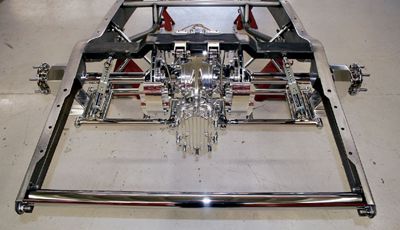
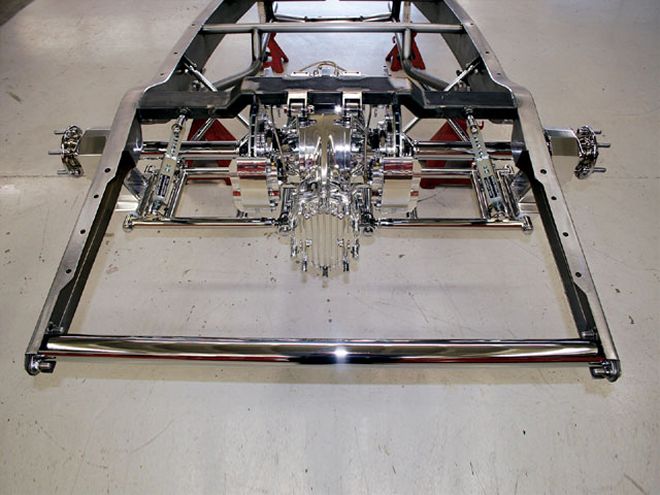
It's hard to believe, but independent rear suspension has been with us for more than 45 years, as it was back in 1961 that Jaguar introduced the XKE, the first automobile to employ such a suspension design. Chevrolet introduced IRS on the 1963 Corvette and hot rodders have been installing them in earlier cars ever since. When this author was growing up in England in the '70s it seemed every hot rod and street machine was jacked up with a chromed Jag IRS under the rear, lit by a red light at night! And, of course, they were all from XKEs, never from the humble S-Type or XJ Series.
There's no denying that an independent rear is visually exciting, especially when chromed, with all the moving parts on display. This is probably what attracted so many early installers to the system rather than the smoother ride. The improved ride quality associated with the IRS design wouldn't be felt with, say, a Jag unit still equipped with four coilover shocks under a lightweight rod. Savvy builders would remove one set of coilovers, which, if the rear pair was removed, offered an even cleaner appearance. Back to aesthetics again! And it's aesthetics that still play a role in the IRS aftermarket. While there's no doubt that today's builders are more concerned with ride quality, there's a reason why most aftermarket IRS units can be had either fully polished or chromed.
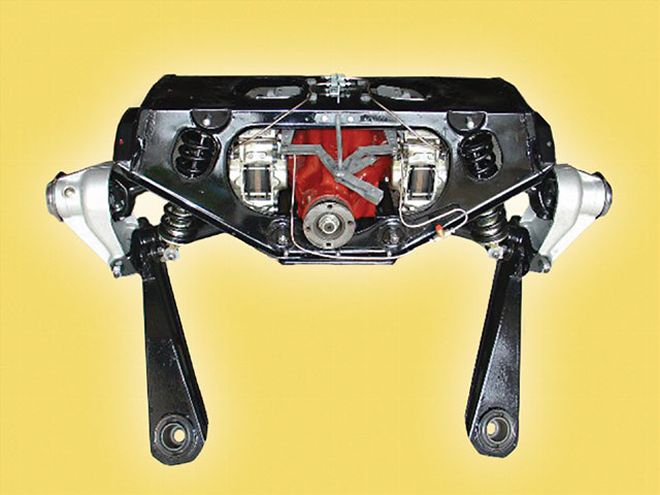 The Jag IRS employs a single 2 1/2-inch-diameter lower control arm with the halfshaft acting as the second control arm.
The Jag IRS employs a single 2 1/2-inch-diameter lower control arm with the halfshaft acting as the second control arm.
But it's not all about appearance. An independent suspension allows each tire to stay firmly planted on the road irrespective of what the other wheels are doing, as they are not connected in the way they are on a live axle. If one wheel drops into a pothole, the opposite wheel stays vertical, as indeed the one in the hole will. This results in improved ride quality and superior handling and road-holding, though, to truly feel the benefits, independent suspensions should be fitted front and rear.
Another benefit of IRS is that it decreases the unsprung weight (the weight of the wheels and suspension) over a live axle setup, and the lower the unsprung weight, the more controllable a car becomes when cornering. It should be noted though, that while an independent suspension offers superior road-holding and cornering abilities, it's not ideal for straight-line performance, as the excessive camber changes incurred as the car squats and launches can lead to horrendous wheel hop resulting in a loss of traction. It is for this reason you don't see too many Corvettes drag racing while using their stock rearends. Plus, they're not legal for the quicker classes in drag racing, as there's no containment should the halfshafts or U-joints fail.
Let's take a look at where this all started, with Jag and Vette rearends, then check out some of the aftermarket options available.
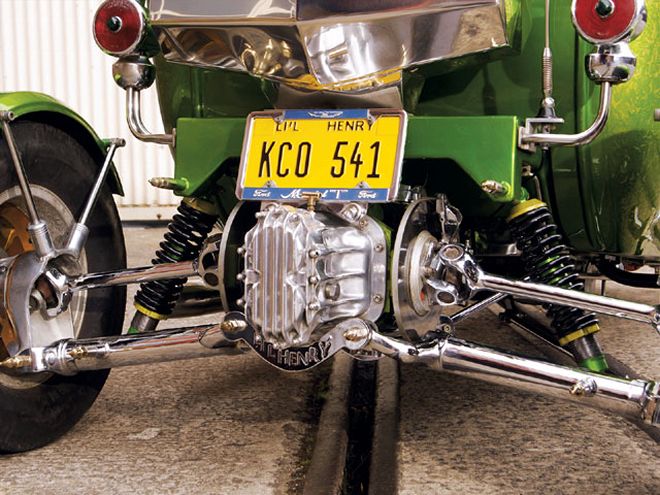 Once uncaged, the Jag IRS becomes a different animal. Used here in a T-bucket, the rear pair of coilovers has been removed, and the front pair replaced with smaller aftermarket adjustable versions.
Once uncaged, the Jag IRS becomes a different animal. Used here in a T-bucket, the rear pair of coilovers has been removed, and the front pair replaced with smaller aftermarket adjustable versions.
Uncaged Jaguar
The Jag unit was the first IRS adopted by hot rodders and kit car owners, especially replica Cobra builders, as it came in varying widths and a wide range of gear ratios, and was relatively easy to mount in other cars, since it was virtually a self-contained unit. The stock IRS in the Jaguar was mounted in a steel cage, which was in turn rubber-mounted to the car, providing insulation against noise and vibration, though, of course, such a butt-ugly system was never going to appeal to hot rodders. The solution? Mount the top of the differential and the upper coilover mounts on a crossmember and replace the ugly pressed-steel radius arms with tubular versions.
Here's a few stats if you like the idea of a Jag rearend: The XKE IRS from '61-70 was 53 1/4 inches wide and came with either 3.54 or 3.31 ratios. The V-12 '70-74 models increased in track to 56 inches with a 3.31 gear. All XJ6 units were 61 3/4 inches wide with 3.54 gears in the Series I ('69-73), 3.31 in the Series II ('73-79), and a super cruiser 2.88 in the Series III ('79-88). The S-Type ('60-69) was 56 inches wide and equipped with anything from a 3.31 to a 4.54 ratio, while the XJ40 introduced in '88 had a completely different non-interchangeable IRS. All XJ-S units were 61 3/4 inches wide with the early versions having a 3.31 ratio and the latter cars a 2.88.
Jaguar fitted stamped I.D. tags on the lower bolts on the crown wheel cover stating the gear ratio, sometimes with the actual ratio and other times with the number of ring-and-pinion teeth. For instance, a 3.31 ratio will be stamped 43/13 (the ratio calculated by dividing the smaller number into the larger). One other point of interest with Jag rears is that up to 1995 they shared the common 5-on-4 3/4-inch bolt pattern with Chevy passenger cars, going metric after that year.
If you're contemplating using a Jag IRS in your project, a great place to start is Concours West, a company that has been installing and modifying these units for 15 years. They offer installation kits, parts, and advice.
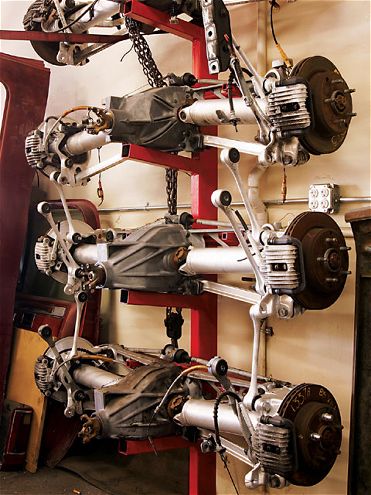 Notice the difference in the third member casing on the upper Vette IRS unit. It is a Dana 36 as opposed to the beefier Dana 44 at the bottom.
Notice the difference in the third member casing on the upper Vette IRS unit. It is a Dana 36 as opposed to the beefier Dana 44 at the bottom.
Corvette
Of course, the Corvette IRS never had, and indeed still doesn't have, coilovers like the Jag, but used a transverse leaf spring. These were originally multileaf steel springs, but were switched in 1980 to a composite fiberglass one-piece leaf spring, which also acts as an antiroll bar on the C5-and-up Vettes, owing to its double spring mounts. The C2, C3, and C4 all had single spring mounting pads in the center, effectively isolating one side of the spring from the other and turning it into two quarter-elliptic springs. Most aftermarket IRS systems based on Corvette parts replace the leaf spring with a pair of coilovers, as the spring setup is perceived to be antiquated, costly, and, in the case of monoleaf springs, complex.
As mentioned above, the C2 was the first Corvette to use independent rear suspension, though most aftermarket companies that offer Vette-based kits employ C4 ('84-96) components. Why would you opt for a Corvette IRS over a Jag? Well, in most parts of the country, the GM unit is going to be more plentiful and they're almost half the weight of their Brit counterpart. Plus, parts such as bearings, seals, and gaskets are easier to source.
Want some stats? A C4 rearend is 62 1/2-inches wide with C5 versions measuring 63 1/4 inch, which will work fine in most fat-fendered or 1950s cars, but will be way too wide for early rods. The C3 is narrower, and is also the last Vette IRS that will accept 15-inch steel wheels, as the 12- and 13-inch discs used on C4s and up require 16s. However, the '84-87 IRS with the parking brake inside the rotor will accept 15-inch aluminum wheels. The C4 came with either a Dana 36 (with gear ratios from 2.79 to 3.43) from automatic cars or a Dana 44 (2.79 to 3.43) from stick-shift Vettes. We'd recommend opting for the Dana 44.
Heidt's
Heidt's is probably best known for its Mustang II-based independent front suspensions, but the company's Superide IRS means you can have Heidt's independent suspension at all four corners of your ride. This IRS was designed from the outset to be adaptable to a wide variety of chassis, yet work perfectly in each application. The use of coilovers means spring rate and shock valving can be adjusted to suit, while frame mount locations for the forward struts and pinion support arms can be determined by the installer to suit their chassis. The option of several stock track widths from 55 to 62 inches, as well as custom widths, means a larger wheel and tire choice is available.
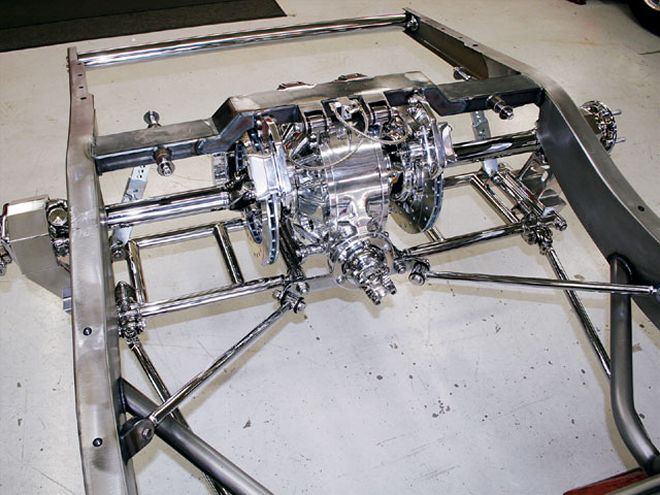 Most of the IRS units shown here have been photographed from the rear, which is what most people will see once the unit is installed, but this view from the front shows the pinion support rods and radius rods (arrows) that connect to brackets on the chassis 'rails, preventing the IRS from "winding up" or tearing itself from its upper mounts on the crossmember.
Most of the IRS units shown here have been photographed from the rear, which is what most people will see once the unit is installed, but this view from the front shows the pinion support rods and radius rods (arrows) that connect to brackets on the chassis 'rails, preventing the IRS from "winding up" or tearing itself from its upper mounts on the crossmember.
The beauty of designing a dedicated suspension system as opposed to adapting one from a production car is that it can be made to look as good as it performs from the outset. The Superide IRS has an aluminum centersection, which can be polished, stainless steel lower control arms are available to replace the standard equipment plain steel versions, and chrome halfshafts are available as well as a range of other appearance options. With aftermarket wheels getting ever larger, and the windows in them increasing in size proportionally, a detailed independent rearend is always going to look good, on even the lowest full-bodied car. Inboard rotors and an IRS will always ensure the best view through such wheels.
We noticed Heidt's offers high-horsepower 3-inch-diameter halfshafts for its IRS, and asked Gary Heidt when he'd recommend installing them. "It's not only a matter of horsepower, as vehicle weight, engine torque, tire size, and other factors will put a high load on the driveline. In general, we recommend them for muscle car applications, as those cars weigh much more than a '32 roadster, which would "launch" quite easily. If someone is in doubt, they should certainly use them."
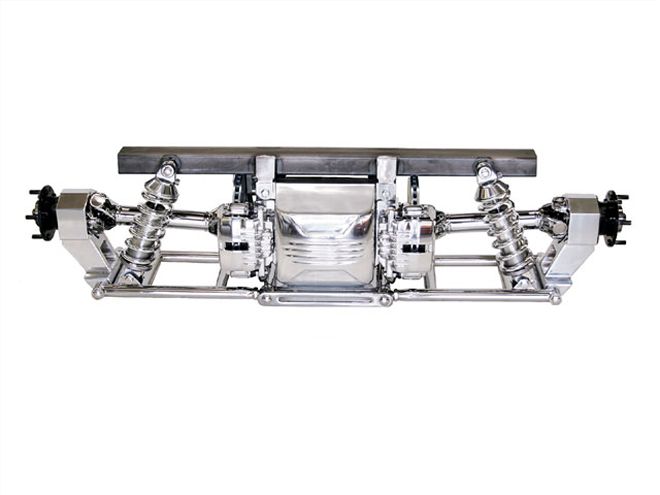 The "standard" Kugel IRS, if there is such a thing, employs 9-inch Ford gears, Corvette heavy-duty universal joints, and steel halfshafts.
The "standard" Kugel IRS, if there is such a thing, employs 9-inch Ford gears, Corvette heavy-duty universal joints, and steel halfshafts.
Flat Out Engineering
Flat Out Engineering started out by offering kits to install Corvette IRS units in classic trucks ('47-59 Chevrolets and '41-64 Fords) but now offers kits for '33-40 Ford cars too. The kits bolt on or weld in, depending on the application. Aldan coilovers or Air Ride Technologies ShockWaves are used in place of the monoleaf spring.
The Ford passenger car kits use C4 IRS units that have been narrowed to 57 inches in width, and include all the crossmembers and bracketry required for fitment. The car kits require welding to the existing chassis. Flat Out's Don McNeil says this is because "Most of these chassis have already been boxed, but not all, so fabricating a weld-on kit made more sense."
Kugel Komponents
An IRS system from Kugel Komponents is supplied fully assembled, pre-aligned and with toe-in and camber adjustments pre-set. It is even filled with gear oil, leaving the customer to just weld the crossmember, radius rod, and pinion support rod bracketry to the chassis.
There are a number of options available for both the 9-inch and quick-change units, such as polishing, limited-slip differential, and tubular stainless control arms. Custom made 11-inch Wilwood rotors are standard, with Corvette aluminum calipers supplied on the 9-inch and billet Wilwood calipers on the Winters Champ Car quick-change IRS. Check the company's Website for all the options available.
Units as narrow as 52 inches have been supplied in the past, and are available in 1-inch increments up to 62 inches, while custom four-bar hub uprights are available for high-horsepower applications.
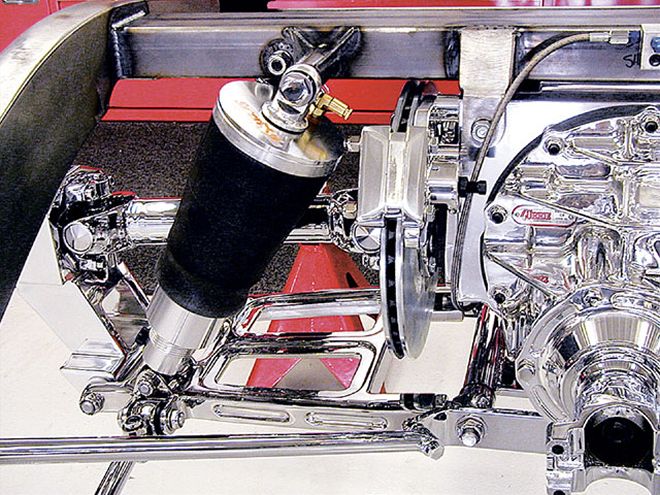 Here's Progressive Automotive's polished and painted '88-96 Vette rear installed with the optional Air Ride Technologies ShockWaves in the company's '55-57 Chevy chassis.
Here's Progressive Automotive's polished and painted '88-96 Vette rear installed with the optional Air Ride Technologies ShockWaves in the company's '55-57 Chevy chassis.
Air Ride Technologies
While Air Ride Technologies doesn't manufacture or even sell IRS units, they do offer rear Shockwaves, which means you can run air suspension with an independent rearend. The rear Shockwaves are specially designed, as the name suggests, for the rear of a vehicle, with more travel and a softer spring rate than those intended for use on the front. The 4-inch diameter 7000 series is designed for vehicles weighing 1500 lbs or less on the rear axle, while the 5-inch-diameter 9000 series is recommended for vehicles weighing 1,500-2,400 lbs on the rear axle.
Progressive Automotive
Progressive Automotive offers its Sweet Ryde C4-based IRS kits for numerous early trucks from many manufacturers, as well as '35-40, '41-48, and all Model A Ford cars; '31-39 and '55-57 Chevy cars; and '37-41 Willys cars. Usually a narrowed rear frame section is required on the cars, and all kits are supplied with such, with all bracketry already attached, as well as Aldan coilovers and mounting hardware. Customer-supplied Corvette parts are narrowed as part of the kit, while 1-inch rear sway bars are also available, as are optional Air Ride Technologies ShockWaves.
Team321
And now for something completely different. Well, not completely, but certainly different enough for us to take notice when we saw it for the first time. This design differs from every-thing else shown here on two counts. First, it doesn't use the halfshaft as a control arm, but actually has an upper and lower arm, and secondly, it employs inboard coilovers. According to Team321's Dave Held, this IRS has been installed in a '35 Ford, a T-bucket, and other custom frames. "The modular design allows for adaptation to a wide variety of vehicles. Team321 can even create a 3D CAD image of your chassis to virtually fit the IRS before any cutting takes place."
The IRS uses an 8.8-inch Ford differential mounted in a subassembly, the wide control arm mount base controls fore and aft wheel deflection without the need for radius arms, and a range of track widths is available from 56-inches. Bolt patterns of 5-on-4 1/2 and 5-on-4 3/4 inches are available and brake options include 11-, 12-, or 13-inch cross-drilled and slotted rotors and Wilwood calipers.